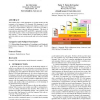105
Voted
SAC
2006
ACM
15 years 10 days ago
2006
ACM
The paper presents an ontology-based approach to service discovery, apt to support flexible and efficient matchmaking between service descriptions. We propose a hybrid approach th...
102
click to vote
HT
2003
ACM
15 years 5 months ago
2003
ACM
Through scenarios in the popular press and technical papers in the research literature, the promise of the Semantic Web has raised a number of different expectations. These expect...
117
click to vote
WWW
2002
ACM
16 years 1 months ago
2002
ACM
Web services -- Web-accessible programs and devices ? are a key application area for the Semantic Web. With the proliferation of Web services and the evolution towards the Semanti...
101
click to vote
WWW
2003
ACM
16 years 1 months ago
2003
ACM
Despite numerous proposals for its creation, the semantic web has yet to achieve widespread adoption. Recently, some researchers have argued that participation in the semantic web...
107
Voted
WWW
2003
ACM
16 years 1 months ago
2003
ACM
The vision of the Semantic Web is to give data on the web a welldefined meaning by representing it in RDF and linking it to commonly accepted ontologies. Most formatted data today...
WWW
2003
ACM
16 years 1 months ago
2003
ACM
The Sematic Web is vitally dependant on a formal meaning for the constructs of its languages. For Semantic Web languages to work well together their formal meanings must employ a ...
102
click to vote
WWW
2003
ACM
16 years 1 months ago
2003
ACM
An important objective of the Semantic Web is to make Electronic Commerce interactions more flexible and automated. To achieve this, standardization of ontologies, message content...
WWW
2004
ACM
16 years 1 months ago
2004
ACM
In this paper, we describe the notion of a semantic information portal. This is a community information portal that exploits the semantic web standards to improve structure, exten...
105
Voted
WWW
2004
ACM
16 years 1 months ago
2004
ACM
Metadata development can be challenging because the vocabulary should be flexible and extensible, widely applicable, interoperable, and both machine and human readable. We describ...
109
Voted
WWW
2004
ACM
16 years 1 months ago
2004
ACM
Two important architectural choices underlie the success of the Web: numerous, independently operated servers speak a common protocol, and a single type of client--the Web browser...




